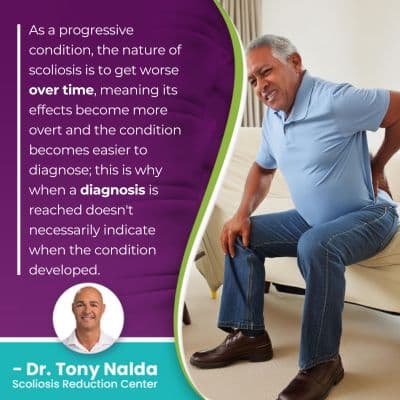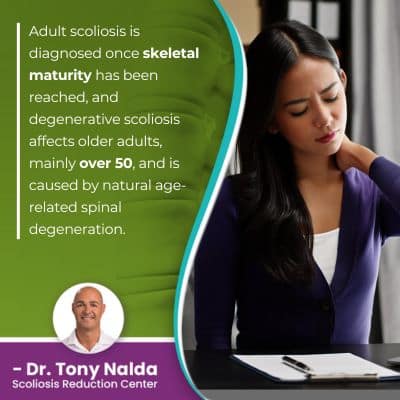At What Age Is Scoliosis Typically Diagnosed? Common Signs

Scoliosis is thought of largely as a childhood condition, but it also affects adults. Scoliosis is diagnosed when its signs become noticeable, and in cases of mild scoliosis, the signs can be subtle: a challenge to early detection.
Scoliosis affects all ages and can be diagnosed at any age, but the most common type of scoliosis is adolescent idiopathic scoliosis, diagnosed between the ages of 10 and 18. Common signs include postural changes such as uneven shoulders and hips.
There are a number of spinal conditions that cause a loss of healthy spinal curves, but scoliosis has some characteristics that set it apart and make it particularly complex to treat.
Table of Contents
How is Scoliosis Diagnosed?
Scoliosis causes an unnatural sideways bending curvature of the spine to develop, and as a 3-dimensional condition, the spine also twists, and this rotational component sets it apart from a number of other common spinal conditions.
Scoliosis is diagnosed through a combined physical examination that includes taking the patient's family history and medical history, along with examining the spine while in a forward-bend position.
A scoliosis X-ray is also needed to officially diagnose scoliosis to see what's happening in and around the spine, to confirm there is a rotational component, and to determine the patient's Cobb angle measurement.
Cobb angle measurement is known as the gold standard in the diagnosis and assessment of scoliosis, and a minimum measurement of 10 degrees is needed to be considered a true scoliosis.
Condition severity is determined by a patient's Cobb angle measurement, and the higher the Cobb angle, the more severe the condition, and the more noticeable its effects are going to be.
So scoliosis isn't diagnosed at a specific age, but more so when its signs become noticeable enough to lead to a diagnosis, and as a progressive condition, how noticeable scoliosis is can change over time.
Scoliosis is Progressive
Treatment plans are shaped around a number of important patient/condition variables such as patient age, condition type, severity, and curvature location.
 As a progressive condition, the nature of scoliosis is to get worse over time, meaning its effects become more overt and the condition becomes easier to diagnose; this is why when a diagnosis is reached doesn't necessarily indicate when the condition developed.
As a progressive condition, the nature of scoliosis is to get worse over time, meaning its effects become more overt and the condition becomes easier to diagnose; this is why when a diagnosis is reached doesn't necessarily indicate when the condition developed.
In fact, it's not uncommon for people to live for years with scoliosis unaware, and as progression occurs and conditions become more noticeable, people seek assessment and diagnosis.
Scoliosis ranges from mild scoliosis to moderate scoliosis, severe and very severe scoliosis, and the signs of mild scoliosis can be subtle, particularly in children for whom scoliosis isn't compressive.
Scoliosis becomes compressive once skeletal maturity has been reached, and that means the spine is no longer growing, so the constant lengthening motion of growth is no longer counteracting the compressive force of the unnatural spinal curve.
It's compression of the spine and its surrounding muscles and nerves that causes the majority of condition-related pain, and this can include muscle pain, back pain, and pain that radiates into the extremities due to nerve damage.
So for children, scoliosis doesn't commonly involve a lot of back pain, so it's a common scenario that adolescents with adolescent idiopathic scoliosis are unaware because the condition's signs can be subtle, and when mild, functional deficits are rare; these adolescents can mature with their scoliosis, and it's not until growth has finished that their scoliosis shows overt signs; pain is the scoliosis symptom that brings adults in for a diagnosis and treatment.
We don't always know what causes scoliosis to develop, but we know it's growth that triggers its progression, which is why childhood scoliosis should always be taken seriously.
Now let's talk about the different ages that scoliosis can be diagnosed at.
Age Groups Affected By Scoliosis
Scoliosis affects every age group.
Babies can be born with congenital scoliosis that's caused by a malformed spine that develops in utero, and this is a rare form affecting approximately 1 in 10,000.
Infants between the ages of 6 months and 3 years old can be diagnosed with infantile scoliosis, and in some cases, scoliosis resolves itself and doesn't get worse with growth, but there is no way of knowing which cases will resolve and which will get worse.
Children diagnosed with scoliosis between the ages of 3 and 10 have early onset juvenile scoliosis; adolescent idiopathic scoliosis, as mentioned, is diagnosed between the ages of 10 and 18.
Adult scoliosis is diagnosed once skeletal maturity has been reached, and degenerative scoliosis affects older adults, mainly over 50, and is caused by natural age-related spinal degeneration.
So as you can see, scoliosis can be diagnosed at any and every age, and while there are never treatment guarantees, what's more important than when a diagnosis is given is how it's responded to with treatment.
Scoliosis Treatment Options
Patients need to understand that there are different ways to address scoliosis with treatment, and the choice to commit to one treatment approach over another can have far-reaching effects.
I want patients to be aware of the pros and cons of all treatment options available to them so they can make informed decisions.
Scoliosis treatment will shape the spine's long-term spinal health and function, so can affect quality of life.
Scoliosis can be treated with surgical treatment or nonsurgical conservative treatment.
Traditional Surgical Treatment
Traditional surgical correction for scoliosis involves spinal fusion surgery, and this is done with the goal of stopping progression.
Spinal fusion typically involves the removal of intervertebral discs sitting between adjacent vertebrae to be fused, and the fusing together of the curve's most-tilted vertebrae into one solid bone; this is done so they can't become more unnaturally-tilted over time (progress), and metal rods are commonly attached to the spine to hold it in place.
 Hardware attached is permanent, and the younger a patient is at the time of their spine surgery, the longer the hardware has to last and perform optimally; hardware malfunction isn't a common complication but it is a risk so should be considered carefully.
Hardware attached is permanent, and the younger a patient is at the time of their spine surgery, the longer the hardware has to last and perform optimally; hardware malfunction isn't a common complication but it is a risk so should be considered carefully.
In addition, the fusing of the spine is contrary to its movement-based design, so many patients are disappointed with the lack of spinal flexibility and range of motion they are left with post-surgery.
Increased back pain is another common effect as the spine is excessively rigid in the fused portion, and this also affects the spine's surrounding muscles; a fused spine is also weaker and more vulnerable to injury.
Spinal fusion is a costly and invasive procedure with risks of infection, excessive blood loss, nerve damage, and adverse reactions to hardware used, and the reality is that many cases of scoliosis don't require surgery.
Nonsurgical Conservative Treatment
Nonsurgical conservative treatment is what patients of the Scoliosis Reduction Center benefit from, and it involves proactive treatment that's started as close to the time of diagnosis as possible.
As a child grows, they are at risk for progression, so when it comes to childhood scoliosis, a focus of treatment is counteracting the condition's progressive nature during growth.
Mild scoliosis is simpler to treat than severe scoliosis, and as virtually every condition is guaranteed to progress at some point, being proactive and starting treatment while conditions are at their mildest have a number of benefits.
Progression makes the spine rigid and less responsive to treatment, so the sooner treatment is started, the more responsive the spine is likely to be; it's also far more effective to proactively work towards preventing progression and increasing condition effects than it is to attempt to reverse once they've developed.
Reducing the Curve
As a structural spinal condition, treatment has to first and foremost impact scoliosis on a structural level, and this phase of treatment involves condition-specific chiropractic care that works towards manually adjusting the position of the curve's most-tilted vertebrae.
When successful, chiropractic adjustments can reposition vertebrae back into alignment with the rest of the spine, restoring as much of the spine's natural curves as possible.
Muscle Strengthening
Physical therapy and scoliosis specific exercises are also applied to ready the spine for treatment, increase its flexibility and strength, and improve muscle symmetry and strength.
A spine that's surrounded by strong muscles is one that's being optimally supported and stabilized.
Corrective Bracing and Rehabilitation
A corrective back brace can be particularly effective on growing spines so is a common facet of childhood scoliosis treatment, and rehabilitation can involve continued chiropractic care and scoliosis exercises customized to further heal and stabilize the spine.
Conclusion
Scoliosis is diagnosed at any age, when its symptoms become noticeable enough to lead to an assessment.
In order to diagnose scoliosis, a physical exam and scoliosis X-ray performed by a medical professional is necessary, and when it comes time to treat scoliosis, the care of a scoliosis specialist is highly recommended; the complex treatment needs of scoliosis are beyond the scope of general medical care.
If scoliosis is diagnosed in children who are still growing, they are the most at risk for continued progression because it's growth spurts that trigger scoliosis getting worse.
There are never treatment guarantees, but with early diagnosis and treatment, there are fewer limits to what can be achieved at any age.
Here at the Center, every treatment plan is fully customized to address specifics of each patient and their condition, and if scoliosis is left untreated, or not treated proactively, severe cases can develop complications.
For patients who have undergone spinal fusion surgery that's unsuccessful, the only recourse is an additional surgery, and the risks increase with each procedure and increasing age.
Common symptoms of scoliosis to watch for in children include one shoulder blade protruding more than the other, one shoulder sitting higher than the other, uneven hips, an uneven waistline difference, a rib cage arch, an uneven waist, chest wall, and changes to balance, coordination, and gait.
The most common symptoms of scoliosis to watch for in adults include foot and leg pain, hand and arm pain, back pain, and a prominent lean to one side.
Regardless of patient age at the time of diagnosis, as a progressive condition, the best time to start treatment is always now.
Dr. Tony Nalda
DOCTOR OF CHIROPRACTIC
After receiving an undergraduate degree in psychology and his Doctorate of Chiropractic from Life University, Dr. Nalda settled in Celebration, Florida and proceeded to build one of Central Florida’s most successful chiropractic clinics.
His experience with patients suffering from scoliosis, and the confusion and frustration they faced, led him to seek a specialty in scoliosis care. In 2006 he completed his Intensive Care Certification from CLEAR Institute, a leading scoliosis educational and certification center.
About Dr. Tony Nalda
 Ready to explore scoliosis treatment? Contact Us Now
Ready to explore scoliosis treatment? Contact Us Now





